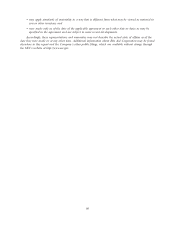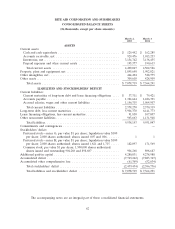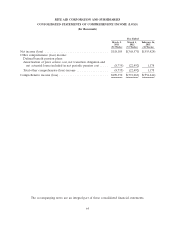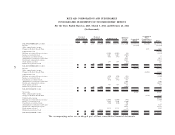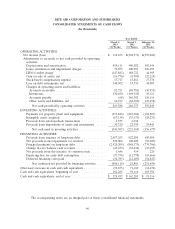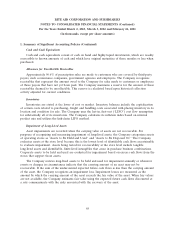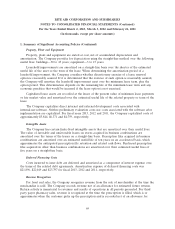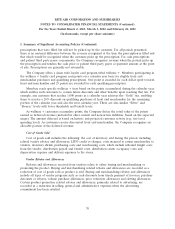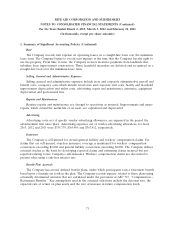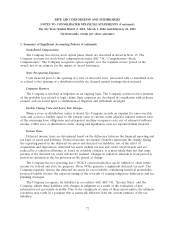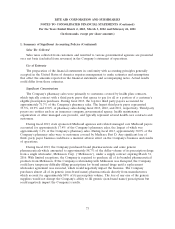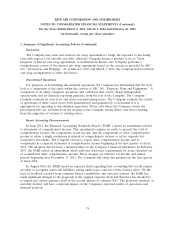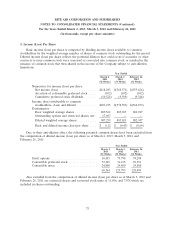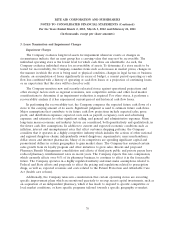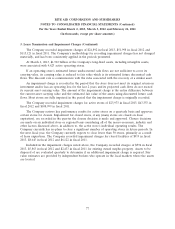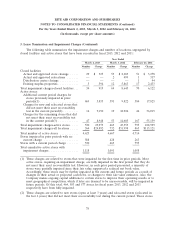Rite Aid 2013 Annual Report Download - page 69
Download and view the complete annual report
Please find page 69 of the 2013 Rite Aid annual report below. You can navigate through the pages in the report by either clicking on the pages listed below, or by using the keyword search tool below to find specific information within the annual report.RITE AID CORPORATION AND SUBSIDIARIES
NOTES TO CONSOLIDATED FINANCIAL STATEMENTS (Continued)
For the Years Ended March 2, 2013, March 3, 2012 and February 26, 2011
(In thousands, except per share amounts)
1. Summary of Significant Accounting Policies (Continued)
Cash and Cash Equivalents
Cash and cash equivalents consist of cash on hand and highly liquid investments, which are readily
convertible to known amounts of cash and which have original maturities of three months or less when
purchased.
Allowance for Uncollectible Receivables
Approximately 96.6% of prescription sales are made to customers who are covered by third-party
payors, such as insurance companies, government agencies and employers. The Company recognizes
receivables that represent the amount owed to the Company for sales made to customers or employees
of those payors that have not yet been paid. The Company maintains a reserve for the amount of these
receivables deemed to be uncollectible. This reserve is calculated based upon historical collection
activity adjusted for current conditions.
Inventories
Inventories are stated at the lower of cost or market. Inventory balances include the capitalization
of certain costs related to purchasing, freight and handling costs associated with placing inventory in its
location and condition for sale. The Company uses the last-in, first-out (‘‘LIFO’’) cost flow assumption
for substantially all of its inventories. The Company calculates its inflation index based on internal
product mix and utilizes the link-chain LIFO method.
Impairment of Long-Lived Assets
Asset impairments are recorded when the carrying value of assets are not recoverable. For
purposes of recognizing and measuring impairment of long-lived assets, the Company categorizes assets
of operating stores as ‘‘Assets to Be Held and Used’’ and ‘‘Assets to Be Disposed Of.’’ The Company
evaluates assets at the store level because this is the lowest level of identifiable cash flows ascertainable
to evaluate impairment. Assets being tested for recoverability at the store level include tangible
long-lived assets and identifiable, finite-lived intangibles that arose in purchase business combinations.
Corporate assets to be held and used are evaluated for impairment based on excess cash flows from the
stores that support those assets.
The Company reviews long-lived assets to be held and used for impairment annually or whenever
events or changes in circumstances indicate that the carrying amount of an asset may not be
recoverable. If the sum of the undiscounted expected future cash flows is less than the carrying amount
of the asset, the Company recognizes an impairment loss. Impairment losses are measured as the
amount by which the carrying amount of the asset exceeds the fair value of the asset. When fair values
are not available, the Company estimates fair value using the expected future cash flows discounted at
a rate commensurate with the risks associated with the recovery of the asset.
68




